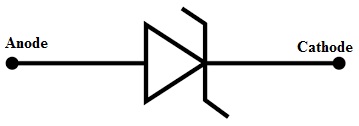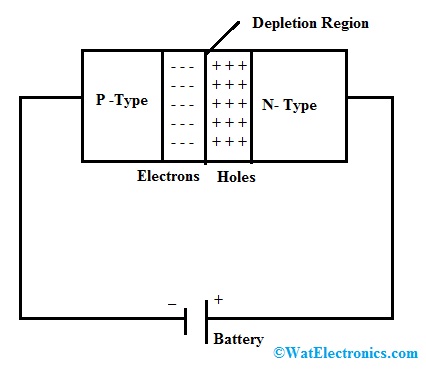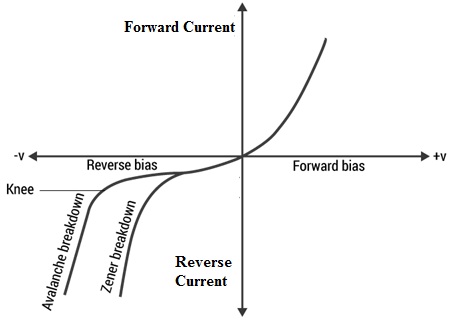A semiconductor diode like an avalanche diode is similar to a Zener diode and this diode operates within the region of reverse bias. The symbol of this diode is the same as a Zener because it is one kind of PN junction diode. The designing of this diode can be done in such a way that, it can resist the breakdown of avalanche without damaging when the reverse current suddenly increased because, when the current increases suddenly within the PN junction diode, then it can damage.
To overcome this, an avalanche diode is used in some particular applications. This article discusses an overview of what is an avalanche diode and it’s working.
What is Avalanche Diode?
A diode that operates in a reverse breakdown region is known as an avalanche diode. These diodes are mainly designed to break at a precise reverse voltage without being damaged. They are applicable in inductive, protective, high voltage circuits once these diodes are connected in series. As compared to a normal diode, an avalanche diode will endure for a long time. So by using these diodes in specific applications, reliability can be improved.
Avalanche breakdown occurs in the materials of both semiconducting & insulating. It is an electric current multiplication form that allows extremely high currents to supply in materials or else good insulators. This kind of breakdown can also occur in solids, liquids otherwise gases once the voltage supply is given beyond the insulating material that is sufficient to speed up free electrons once they hit atoms within the material, and then they can knock other charge carriers.
Avalanche takes place very fast & consequently, these diodes are the best surge-suppression components. In an electric system, an avalanche diode is used like a valve to control & protect the system from a surplus voltage or pressure.
Avalanche Diode Symbol
The avalanche diode symbol is shown below. This diode includes two terminals namely anode & cathode. The materials used to design this diode are P-type & N-type. It works under reverse biased conditions. The avalanche diode doping changes from a Zener diode. This diode is lightly doped & thus it forms a depletion layer that includes a high width.

Avalanche Diode Symbol
Since the depletion layer width decides the breakdown voltage within the diode. Thus, the avalanche breakdown voltage takes place at high voltage as compared to Zener breakdown voltage.
Avalanche Diode Working
The flow of current in the PN junction diode allows only when it is connected in forwarding bias condition whereas an avalanche diode, allows the flow of current to supply in both biasing conditions like forward & reverse. Usually, it is utilized in reverse bias conditions. The avalanche diode’s operation in the forward bias condition is similar to the normal PN junction diode operation within the forward bias.
Once this diode is allied in reverse bias condition, then the applied voltage is called reverse bias voltage. The working of an avalanche diode can be done once the reverse voltage is higher as compared to the reverse breakdown voltage.
So, this voltage is called when the reverse bias voltage is applied where the breakdown takes place at the PN junction. So the diode allows the flow of current in this condition. As compared to a PN junction diode, this type of diode also includes two layers namely P-layer & N-layer. In P-layer, the majority of charge carriers are holes whereas in N-layer the majority of charge carriers are electrons.

Avalanche Diode Working
Once a reverse bias voltage is given to this diode, then the majority of charge carriers will go away from the PN junction. So, the depletion region width increases & the majority of charge carriers will restrict the flow of current. In this state, a small amount of current will supply throughout the circuit because of the minority charge carriers which is called reverse leakage current.
Once the reverse bias voltage enhances the gain of energy through the minority charge carriers will increases so that minority charge carriers will move with high speed. These charge carriers will collide through atoms to transfer the energy toward the valence electrons. These electrons will be separated from the parent atom & turns into a free electrons.
This process is continuous and thus, the number of electrons enhances exponentially. Now, an increase in voltage will increase electric current suddenly. This will damage the depletion area. So an avalanche breakdown will occur.
The breakdown voltage where avalanche breakdown takes place mainly depends on the level of doping of semiconductor material utilized. If the level of doping enhances, then the breakdown voltage will decrease for these diodes.
Specifications
The specifications of the avalanche diode will determine the diode’s functionality.
Forward Voltage
The forward voltage is the specified voltage across the terminals of the diode that outcomes from the current flow within the forward way.
Reverse Voltage
Reverse voltage is the highest acceptable reverse voltage that can be frequently applied.
Breakdown Voltage
Breakdown voltage is the reverse voltage where small voltage increases the reverse current will be increased.
Avalanche Diode Characteristics
The characteristic of the avalanche diode is approximately related to the Zener diode. The avalanche breakdown takes place due to the minority charge carriers within the PN junction. The designing of these diodes can be done the voltage drop which is occurred within the breakdown region is low as compared to the voltage drop within the more zen diode. The VI characteristic curve of the avalanche diode is shown below.

Characteristics
The VI characteristics are nothing but the difference of current for the voltage applied to the diode. The above graph demonstrates the mixed characteristics of the Zener & Avalanche breakdown. It is observed that both breakdowns will occur once a diode is connected in a reverse bias state.
Zener breakdown mainly takes place at below 4V of breakdown voltage that is specified with ‘Vz’. Similarly, avalanche breakdown takes place at above 6V of breakdown voltage that is specified with VBR.
Please refer to this link for Choosing resistor values for diodes.
Advantages
The advantages of avalanche diode include the following.
- This diode protects the circuit from damage once the voltage or current increases suddenly.
- The doped within the semiconductor materials mainly used for the designing of this diode is low.
- The current in avalanche breakdown gives a high current
- It has high performance
Disadvantages
The disadvantages of avalanche diode include the following.
- The diode output is not linear
- As compared to Zener breakdown, the necessary avalanche breakdown voltage is higher.
- Low reliability
- As compared to a normal PN junction diode, the noise production is higher within the diode.
Applications
The applications of avalanche diode include the following.
- It is used to guard the circuit against excess current or voltage
- This diode is used as a white noise generator and this diode generates RF noise. So, it is used in radio gears as a source of the noise.
- It allows the flow of current in reverse bias without harming itself if the voltage in reverse bias is high as compared to reverse breakdown voltage.
- This diode is used where the device needs high current because it includes high capacity multiplication.
- This diode is used as a single photon detector in different applications
- This diode is used in the detection of microwave frequency because it works like a negative resistance device
- This diode generates relaxing & calm noise
What is Avalanche Breakdown Voltage?
Once the reverse bias voltage is enhanced beyond a PN junction, and the reverse saturation current will stay stable up to a fixed point. Further, if we increase the reverse bias voltage then it will collapse the junction
This critical reverse bias voltage value where reverse current increases suddenly then Avalanche breakdown takes place which is called the avalanche breakdown voltage. This type of breakdown mainly occurs where the breakdown voltage is above 6 V.
How Avalanche Breakdown is not Reversible & Zener Breakdown is Reversible?
The breakdown like Avalanche is not reversible whereas Zener is reversible. So the breakdown of avalanche mainly occurs because of the crash of charge carriers through the nearby atoms as well as because of the carrier multiplication.
But, Zener Breakdown mainly takes place because of the covalent bonds breaking through the tough electric field beyond the PN-junction. The power rating in the Zener breakdown is not enhanced.
If we connect a resistor in series with a diode then the breakdown of the avalanche will be reversible.
If a PN junction is in Zener breakdown state & if we decrease the exterior reverse bias voltage, then the PN junction is not harmed but it comes to its early condition. But, if a PN junction is in the condition of avalanche breakdown & if we decrease the voltage in reverse bias, then the PN junction cannot come back to its early state which means, in avalanche breakdown state, the PN junction is damaged permanently.
Please refer to this link to know more about PN Junction Diode MCQs & Clipper Circuit MCQs.
Please refer to this link to know more about Clippers and Clampers & Diode Approximation.
Thus, this is all about an overview of an Avalanche diode and the main function of this diode is to break down at an exact high breakdown voltage. These kinds of diodes are mainly used for electronic device protection from excess voltages. These diodes utilize a fixed voltage to begin the effect of avalanche rather than permitting the voltage to cause harm to the diode. This diode gives the necessary protection for the devices to function continuously. Here is a question for you, what is the Zener effect?